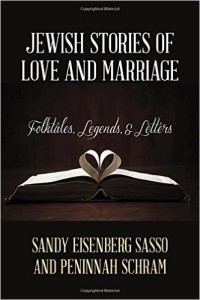
by Sandy Eisenberg Sasso
Secrets of Jewish Love and Marriage
Ten years ago my daughter was getting married, and I wanted to give her a gift of Jewish love stories which included her own. In searching for the very best stories, ones that might share love’s wisdom, I looked to a good friend and folklorist, Peninnah Schram. She suggested a number of beautiful narratives. As we talked, I proposed that we put together an anthology of Jewish stories of love and marriage. Not only could we provide an important historical collection, we could also show the evolving and eternal nature of romance. There was nothing like this available.
 Neither of us had the time then, but we never abandoned the idea. One day we would create a book, Jewish Stories of Love and Marriage. When my daughter and son-in-law were celebrating their tenth anniversary, we were ready. Before we could even off a proposal to a publisher, we would have to do our research. All through those study months, Peninnah and I would call each other to share what amazing material we were finding. Each narrative had its own power and beauty; together they wove a tale of joy and sorrow, defeat and triumph, spontaneity and tenacity. Every day we found a new story, it was like opening a surprise gift. Every night I would pour a glass of wine and read those legends to my husband, Dennis. It was like renewing our vows.
Neither of us had the time then, but we never abandoned the idea. One day we would create a book, Jewish Stories of Love and Marriage. When my daughter and son-in-law were celebrating their tenth anniversary, we were ready. Before we could even off a proposal to a publisher, we would have to do our research. All through those study months, Peninnah and I would call each other to share what amazing material we were finding. Each narrative had its own power and beauty; together they wove a tale of joy and sorrow, defeat and triumph, spontaneity and tenacity. Every day we found a new story, it was like opening a surprise gift. Every night I would pour a glass of wine and read those legends to my husband, Dennis. It was like renewing our vows.
One unexpected discovery was the story of Pearl, the wife of Rabbi Judah Loew of Prague. I knew the rabbi of Golem fame, but not Pearl, the clever and wise student of Talmud. The two are buried side by side in the Jewish Cemetery of Prague. One tombstone sits over both their graves. When I stood before that grave with a group of fellow travelers, I told her little known story.
We hadn’t anticipated including love letters in the anthology. But we kept finding such stunning correspondence that we decided to devote a section of the book to them. Reading the correspondence of Alfred Dreyfus (the Jewish French captain falsely accused of treason) and Lucie Hadamard, Martin and Paula Winkler Buber, we were witness to playful wit and compassionate longing. We came to understand in a much deeper way how those relationships sustained and fostered their creativity. Particularly important for us was how these letters often gave women a voice.
We had the privilege of publishing the love letters written to Regina Jonas, the first woman to be ordained as a rabbi in Berlin in 1935 and who died in Auschwitz. Among the many folders that attest to her rabbinate there is one with more than 100 letters from her beloved. For the first time, those letters give a glimpse of her personal life and of the love she found for herself amidst enormous adversity.
We knew the book would not be complete without the stories of our generation. We wanted narratives of modern love with all its complexities. We expected to see differences and we did. But what startled us the most were the similarities.
While how people come to meet and fall in love has changed dramatically, there is so much that remains the same. In the past relationships were mostly heterosexual, local and within familiar communities and cultures; now they include gay and lesbian couples and they span cultures and continents. In the past dating was short, marriage was early and matchmakers brought couples together. Handwritten letters were the form of communication. Now the internet is often the matchmaker; we text and tweet, date longer and marry later; bonds are easier to dissolve.
Still in every story, it is love that helps people survive imprisonment, war and serious illness. No couple rides off into the sunset on a white horse with the words, “and they lived happily ever after.” There are challenges, jealousy and competition, conflict and war. Relationships are forged under difficult circumstances, tested by trials. Perseverance, forgiveness, patience are still the cement that bind two individuals. The sensuousness and physicality of the Song of Songs still resonates today. Hearts are broken, but somehow they heal.
Just after the book was published, I had the privilege of officiating at the wedding of a couple whose grandparents letters are in the anthology. I read them under the huppah. From generation to generation, the story of falling in love and growing in love continues.